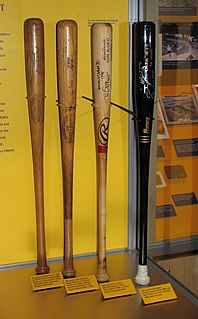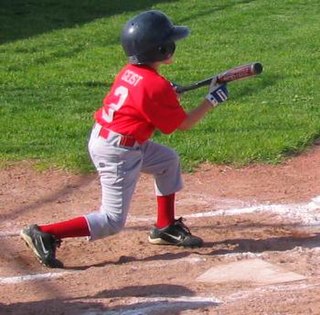Slap bunting is an offensive baseball and softball technique described as "the idea behind the skill is to hit the ball to a place on the infield that's farthest from the place where the out needs to be made". [1]

Baseball is a bat-and-ball game played between two opposing teams who take turns batting and fielding. The game proceeds when a player on the fielding team, called the pitcher, throws a ball which a player on the batting team tries to hit with a bat. The objectives of the offensive team are to hit the ball into the field of play, and to run the bases—having its runners advance counter-clockwise around four bases to score what are called "runs". The objective of the defensive team is to prevent batters from becoming runners, and to prevent runners' advance around the bases. A run is scored when a runner legally advances around the bases in order and touches home plate. The team that scores the most runs by the end of the game is the winner.

Softball is a variant of baseball played with a larger ball on a field that has base lengths of 60 feet and a pitcher's mound that ranges from 35-43 feet away from home plate. It was invented in 1887 in Chicago, Illinois, United States as an indoor game. The game moves at a faster pace than traditional baseball. There is less time for the base runner to get to first while the opponent fields the ball; yet, the fielder has less time to field the ball while the opponent is running down to first base. The name softball was given to the game in 1926, because the ball used to be soft, however in modern day usage, the balls are hard.
To execute slap bunting, the player is almost always in the back of the left-hand side of home plate, feet slightly open to right field, and choked up slightly on the bat. The moment the pitch is released from the pitcher's hand, the player must rotate his hips toward the pitcher and then cross his back (left) foot over his front foot, moving up to the very front edge of the batter's box. [2] His shoulders should face the pitcher at this point. If the pitch is in the strike zone, the batter should then extend his arms so that the bat is at the correct angle for where he wants to place the ball — the barrel trailing the hands if he wants the ball to go to the left side of the field, and the opposite if he wants it to go to the right.

A baseball bat is a smooth wooden or metal club used in the sport of baseball to hit the ball after it is thrown by the pitcher. By regulation it may be no more than 2.75 inches (7.0 cm) in diameter at the thickest part and no more than 42 inches (1.067 m) in length. Although historically bats approaching 3 pounds (1.4 kg) were swung, today bats of 33 ounces (0.94 kg) are common, topping out at 34 ounces (0.96 kg) to 36 ounces (1.0 kg).

In baseball, a pitch is the act of throwing a baseball toward home plate to start a play. The term comes from the Knickerbocker Rules. Originally, the ball had to be literally "pitched" underhand, as with pitching horseshoes. Overhand throwing was not allowed until 1884.

The human shoulder is made up of three bones: the clavicle (collarbone), the scapula, and the humerus as well as associated muscles, ligaments and tendons. The articulations between the bones of the shoulder make up the shoulder joints. The shoulder joint, also known as the glenohumeral joint, is the major joint of the shoulder, but can more broadly include the acromioclavicular joint. In human anatomy, the shoulder joint comprises the part of the body where the humerus attaches to the scapula, and the head sits in the glenoid cavity. The shoulder is the group of structures in the region of the joint.
The technique is quite common in softball because of the difficulty of getting a hit with a pitcher only 40 feet (12 m) away. By already being in the front of the batter's box with the batter's body turned halfway toward first base, the batter already has some momentum toward first base and might be in better position to get a base hit. [1]
The technique is often successful in sacrifice circumstances, where the placement of the ball could help advance a runner already on base. It is also often used when batters are having difficulty getting a hit off of a difficult pitcher, or when they have a better opportunity of getting on base because of the slap bunt than a hit, perhaps because of the player's running speed.
Some advanced players might perform a slap hit, which is the same technique except that the player swings to place the ball in an infield hole or over the infielders' heads.
An infielder is a baseball player stationed at one of four defensive "infield" positions on the baseball field.





